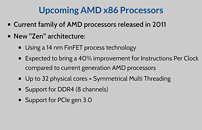- Joined
- Oct 9, 2007
- Messages
- 47,244 (7.54/day)
- Location
- Hyderabad, India
| System Name | RBMK-1000 |
|---|---|
| Processor | AMD Ryzen 7 5700G |
| Motherboard | ASUS ROG Strix B450-E Gaming |
| Cooling | DeepCool Gammax L240 V2 |
| Memory | 2x 8GB G.Skill Sniper X |
| Video Card(s) | Palit GeForce RTX 2080 SUPER GameRock |
| Storage | Western Digital Black NVMe 512GB |
| Display(s) | BenQ 1440p 60 Hz 27-inch |
| Case | Corsair Carbide 100R |
| Audio Device(s) | ASUS SupremeFX S1220A |
| Power Supply | Cooler Master MWE Gold 650W |
| Mouse | ASUS ROG Strix Impact |
| Keyboard | Gamdias Hermes E2 |
| Software | Windows 11 Pro |
CERN engineer Liviu Valsan, in a recent presentation on datacenter hardware trends, presented a curious looking slide that highlights some of the key features of AMD's upcoming "Zen" CPU architecture. We know from a recent story that the architecture is scalable up to 32 cores per socket, and that AMD is building these chips on the 14 nanometer FinFET process.
Among the other key features detailed on the slide are symmetric multi-threading (SMT). Implemented for over a decade by Intel as HyperThreading Technology, SMT exposes a physical core as two logical CPUs to the software, letting it make better use of the hardware resources. Another feature is talk of up to eight DDR4 memory channels. This could mean that AMD is readying a product to compete with the Xeon E7 series. Lastly, the slide mentions that "Zen" could bring about IPC improvements that are 40 percent higher than the current architecture.

View at TechPowerUp Main Site
Among the other key features detailed on the slide are symmetric multi-threading (SMT). Implemented for over a decade by Intel as HyperThreading Technology, SMT exposes a physical core as two logical CPUs to the software, letting it make better use of the hardware resources. Another feature is talk of up to eight DDR4 memory channels. This could mean that AMD is readying a product to compete with the Xeon E7 series. Lastly, the slide mentions that "Zen" could bring about IPC improvements that are 40 percent higher than the current architecture.

View at TechPowerUp Main Site






